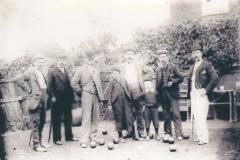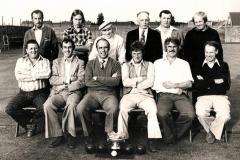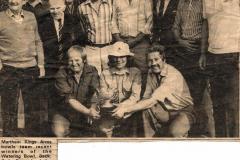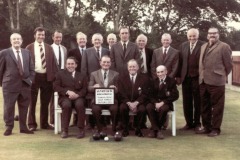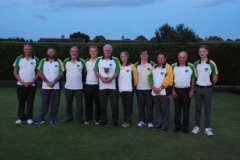This page is long and covers four sports popular in Martham. You can jump to any one by clicking your choice:-
Bowls at Martham
Cricket at Martham
Football at Martham
Quoits at Martham
At the start of 20th century the working classes began to have slightly more leisure time and became involved with sports. People took an active part in football, bowls and quoits. Cricket was also popular but was considered to be more of a gentleman’s game indulged in by the upper classes but gradually things began to change and class intermingling began to change society.
Bowls
Bowls flourished in the Flegg area during the mid 19th century and was certainly very popular in Martham where, like several other villages, it was either played at large country houses or on greens at the rear of pubs.
Bowls in Martham was evident as early as 1853 when the Norfolk Chronicle newspaper printed the report shown below on 15th October that year about a competition at the King’s Arms when the landlord William Rogers had provided a prize of a silver tankard. It is obvious from this that the green had been there for sometime. The winner was John Hunt the village Postmaster and the runner-up was George Barber a local farmer and wheelwright.
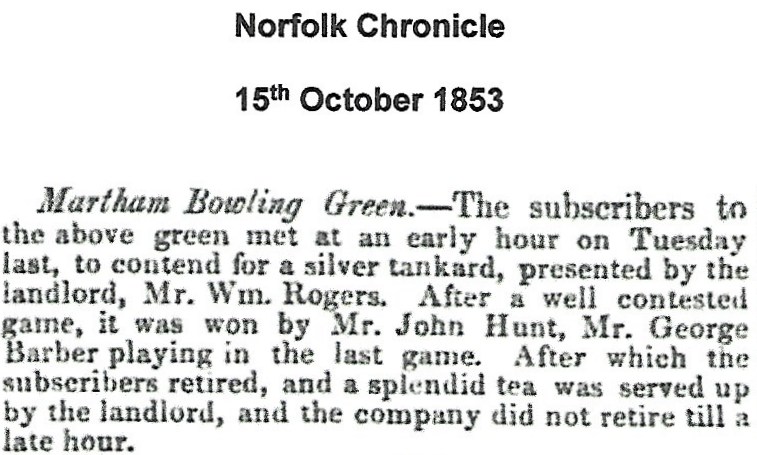
The game continued to be played at the King’s Arms for many years. William Rogers son Richard Rogers took over the tenancy in 1858. He was there until 1877 and regularly advertised the availability of the green there where people could play based on a fee or subscription.
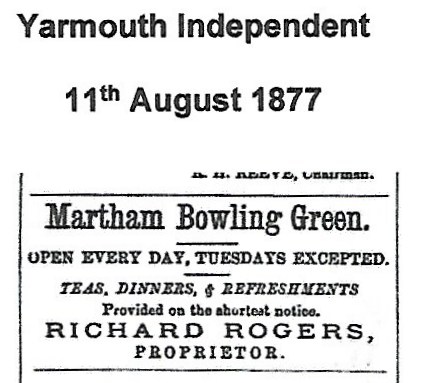
By 1906 the game was organised as the West Flegg Bowling League which Martham took part both in that year and in 1907. The War years saw a cessation of play but by 1921 the village had a new green at William Edward Cooke’s home at Columbary on Repps Road. The team was called the Martham West End Bowling Club. The Yarmouth Independent newspaper announced its opening in an article dated 7th May 1921 which is shown here:
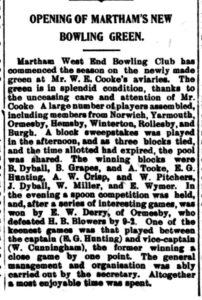
At the east end of the village a new hall had been provided in 1920 as a direct result of commemorating the end of the First World War and a bowling green had been built at the back of what was known as The Institute on White Street. There was a close fought finish to the 1923 season when Martham Institute and Ormesby Institute tied on the same number of points after which Martham triumphed by one shot in a play-off. In the years running up to the second world war most of the games seemed to be friendlies rather than league matches but the green at the King’s Arms remained popular.
In the late 1970’s the game was so popular that another green was opened at Hall Road on former market garden land provided by the Lown family at the back of their coal yard. This remained in use until just before the new green and club house were built on an extension to the Playing Field in 2006. At about the same time the green at the King’s Arms also fell into disuse. The splendid new facilities off Rollesby Road boosted the village teams, including a junior section, to new levels and they enjoy a high reputation amongst the local bowls community. The club were County League Champions and Subsidiary Cup Winners in 2019.
Bowls photographs: click a thumbnail for a close-up and scroll through all the images from there.
Cricket
Nationally cricket grew in popularity during the 19th century. County Championships began in 1864 but in those early days it tended to be confined to the land owning classes with pitches in country houses. This was epitomized by the pitch at Rollesby Hall where Martham played some of its matches as early as the 1870’s one of the earliest being in 1875 between a Martham eleven and Acle. Records showed Martham played at both Rollesby Hall and the village green in 1880-1900 as illustrated by the photograph shown below.
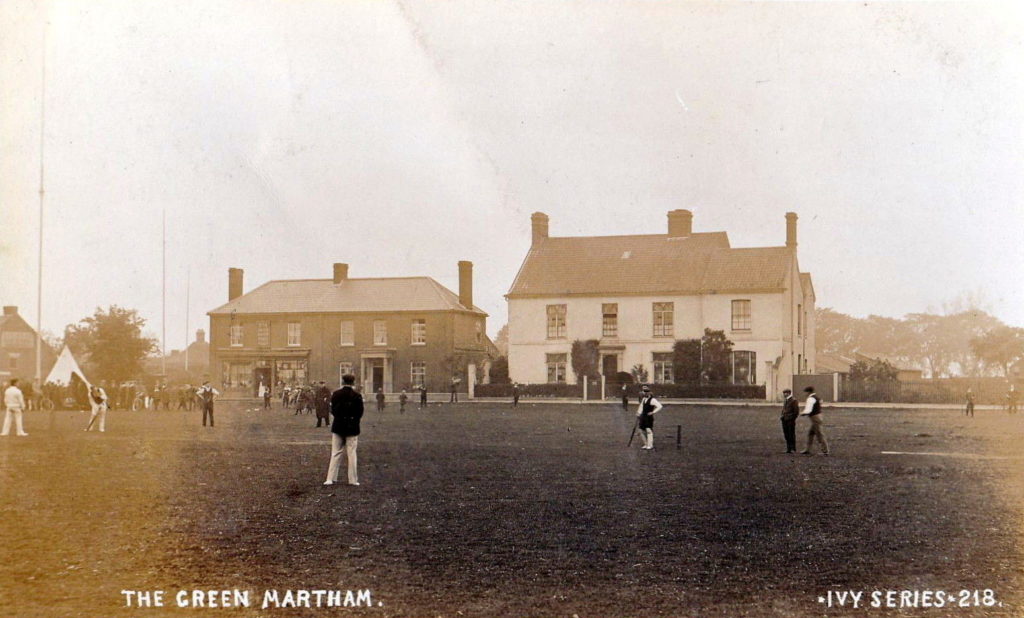
It seems that at this stage popularity had grown to such an extent that the village was capable of fielding two teams. There were several cricket matches played over the August Bank Holiday that year one of which was between Martham 2nd eleven and St Andrews, Great Yarmouth which Martham won. The result was reported in the Norfolk Chronicle and is shown below.
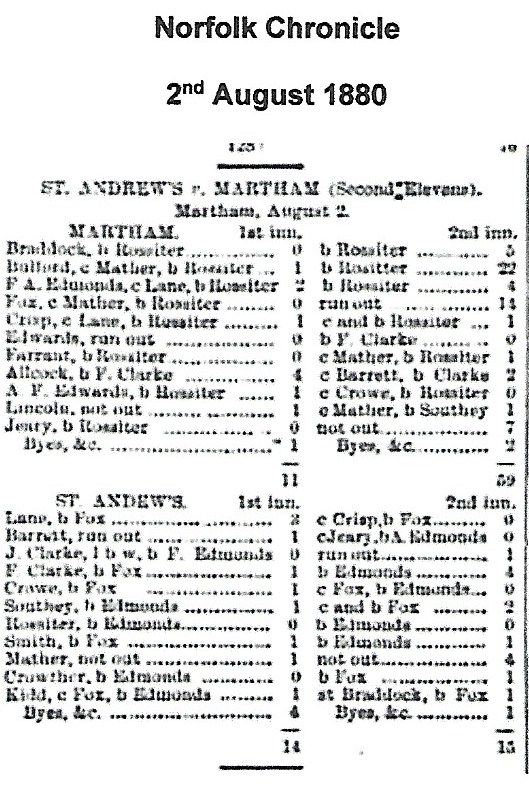
At the end of that season twenty-one members of the Martham club met at the King’s Arms for a dinner to celebrate a season in which they had won 13 of 16 matches they had played.
Judging by the low scores recorded pitches were in a very poor state and favoured the bowlers. The Martham pitch was recorded as being in a shocking rough state and a disgrace to the club in 1897.
In 1910 a meeting was held to establish a Yarmouth & District Cricket League. Martham joined five other teams for the inaugural 1911 season playing their matches on a field owned by George Chapman the butcher. They finished fifth with three wins and a draw from ten matches and remained in the league until it folded at the end of the 1913 season.
Cricket made a slow recovery after the First World War and Martham did not take part until 1921. In 1923 they joined in the Falcon Cup competition in its first season. Martham were the only Flegg team to take part. The competition was organised into two divisions with the divisional winners playing in the final. Martham came top in their division by winning all eight matches and played Langley Park & Loddon at the Norwich Union neutral ground in the final. Sadly, they lost by 36 runs to 28 in a very low scoring game.
By this time Martham were playing at a new ground and had use of a pavilion at Starkings Meadow which was where Willow Way starts now on the east side of Rollesby Road and opposite the Fire Station site. At the time it ran along the north side of the railway line. The changing room or pavilion ran alongside Rollesby Road. The following article from around 1938 implies they had been playing there since the mid 1920’s.
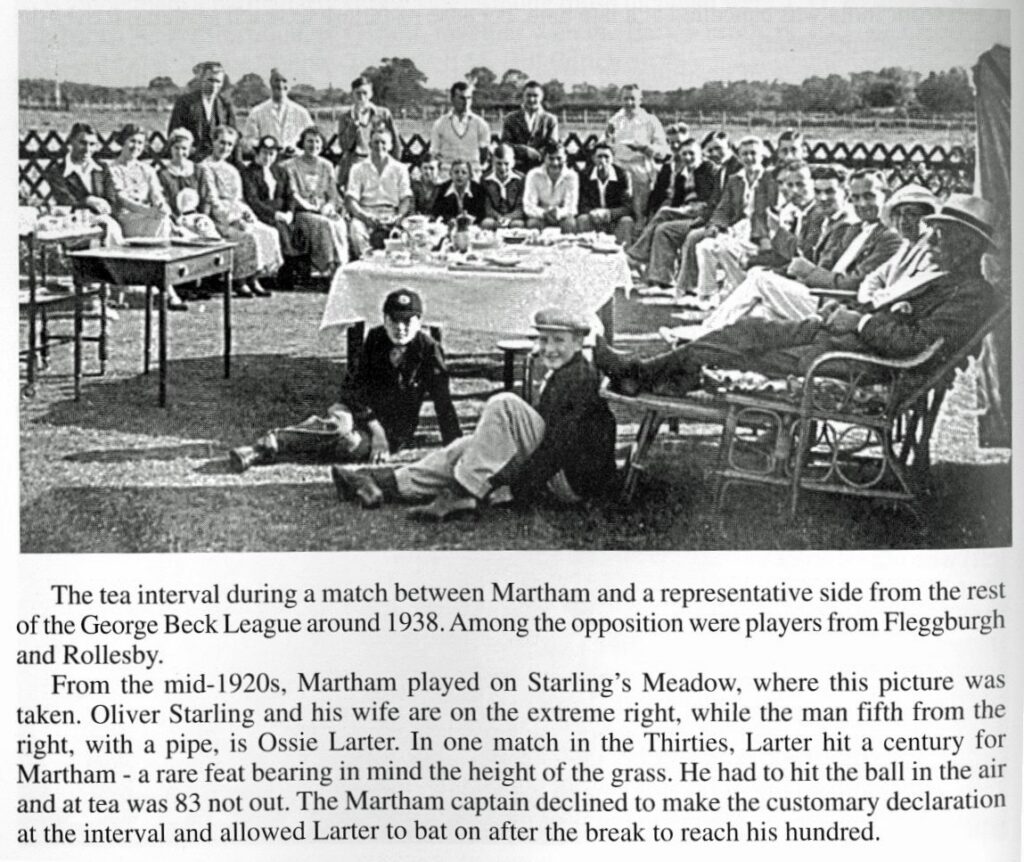
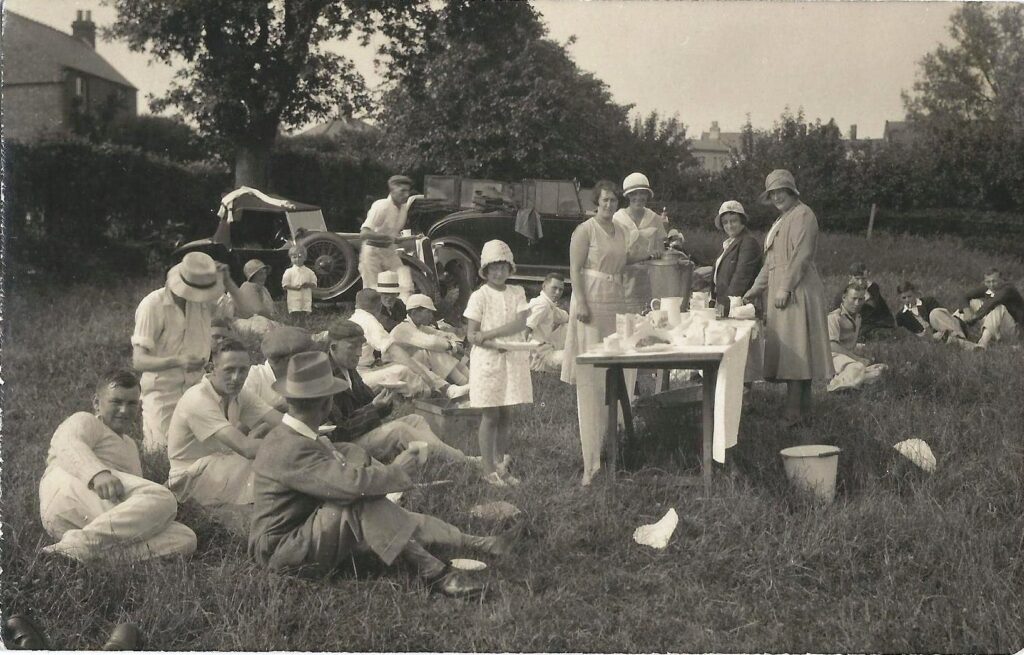
By 1929 Martham were still competing in the Falcon Cup with William Temple taking over as secretary to the club in 1931, a position he held for many years thereafter. The club captain was Robert Kirkland the shop keeper and draper and leading batsmen were Oswald Larter and Mr C Hill whilst the principal bowlers were Thomas Dyball and Captain Jeary.
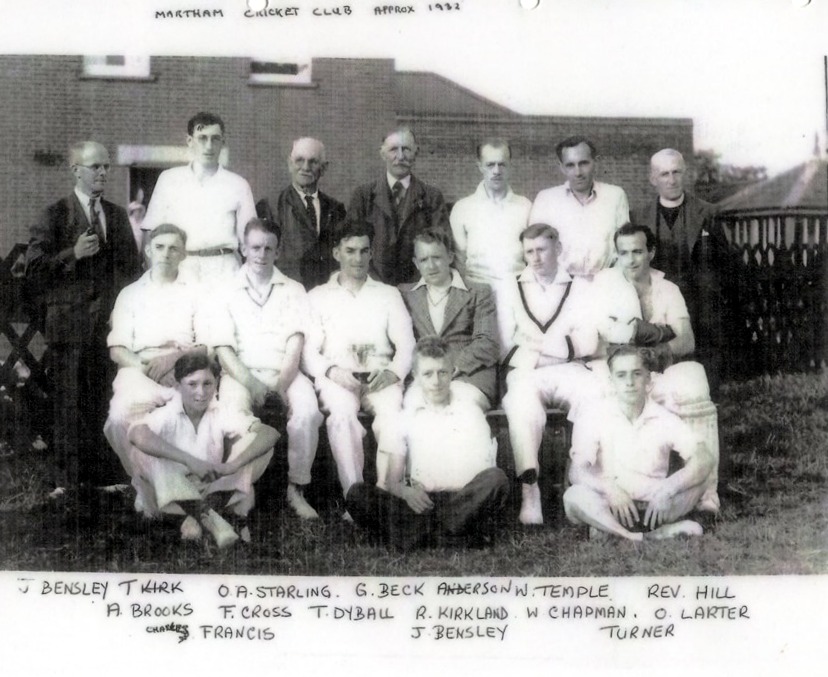
By 1933 Martham were playing in two competitions: the Falcon Cup and the newer Beck League but the demand on the pool of available players stretched their resources and they failed to make an impression in either tournament.
In an end of 1934 season finale Martham, as league winners, beat a Rest of the League side by one run and the players scorecard was:
| Martham | The Rest | ||
| Thomas Dyball b J Trett | 12 | A Carter c Larter b Cross | 4 |
| Oswald Larter b J Emmerson | 4 | J Newman c Turner b Cross | 24 |
| William Chapman c Miller b Carter | 14 | T Collyer b Cross | 0 |
| E Kirk c Curtis b Trett | 1 | M Curtis b Chapman | 2 |
| C Anderson lbw Collyer | 13 | B Hastings b Brooks b Kirk | 9 |
| C Francis b Trett | 0 | W Trett c Kirkland b Chapman | 11 |
| Fred Cross b Collyer | 3 | J Emmerson b Chapman | 4 |
| Robert Kirkland c Miller b Emmerson | 6 | B Fakes – not out | 5 |
| C Turner b Carter | 1 | J Trett c Brooks b Chapman | 2 |
| William Temple – not out | 3 | C Miller c Kik b Chapman | 0 |
| A Brooks c Trett b Carter | 0 | H Branchett b Fred Cross | 0 |
| Extras | 7 | Extras | 2 |
| Total | 64 | Total | 63 |
In 1935 a strong Martham team beat Winterton in the Loveday Cup despite T Rackham taking a hat trick of wickets for the losing side. Martham also won the league after a three way draw with Filby and Freethorpe and a play off to find the winners.
In 1938 Martham lost in the final of the Loveday Cup to Halvergate.
There was an understandable cessation of play during the second world war. Things started again in 1946 after a great deal of work on Starlings meadow that saw the ground and pavilion badly damaged by enemy action in 1940. Repair work paid off as they won their first match with Oswald Larter scoring 45, not out, of Martham’s 68 runs.
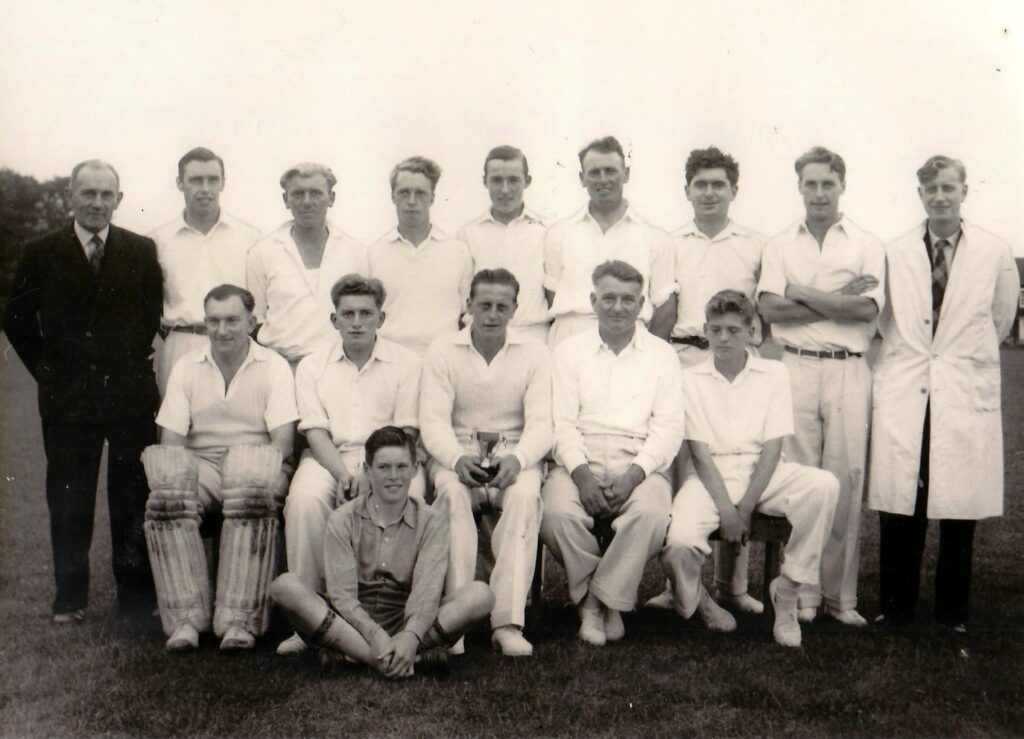
Martham eventually got to play on a new purpose-built home ground when the Coronation Playing Field in Rollesby Road was opened in 1953 and they enjoyed even better facilities when a new pavilion was opened there in May 1959. They must have liked their new home as the photograph below shows them with a hat full of trophies in 1958.
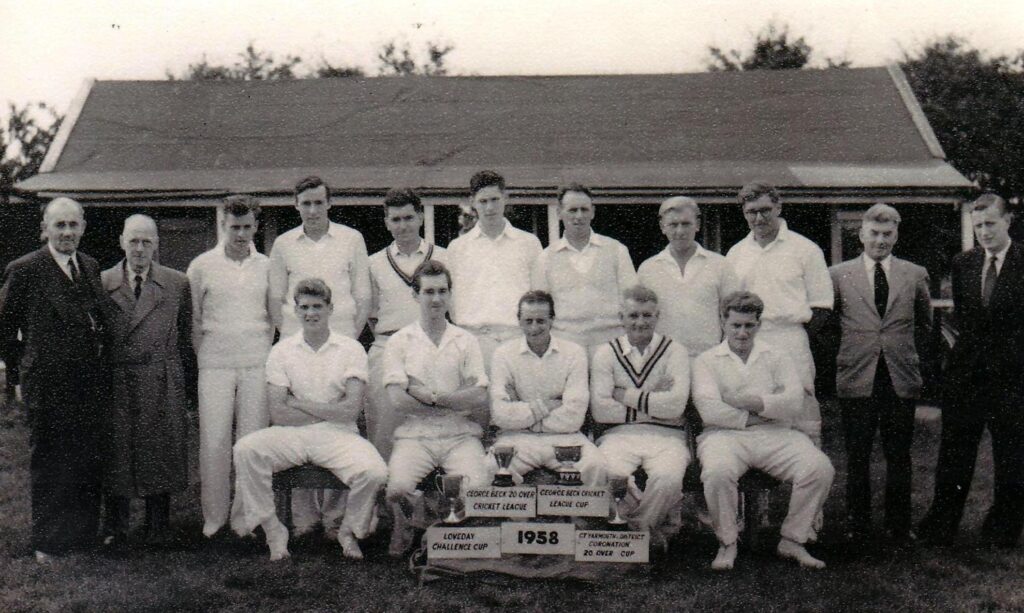
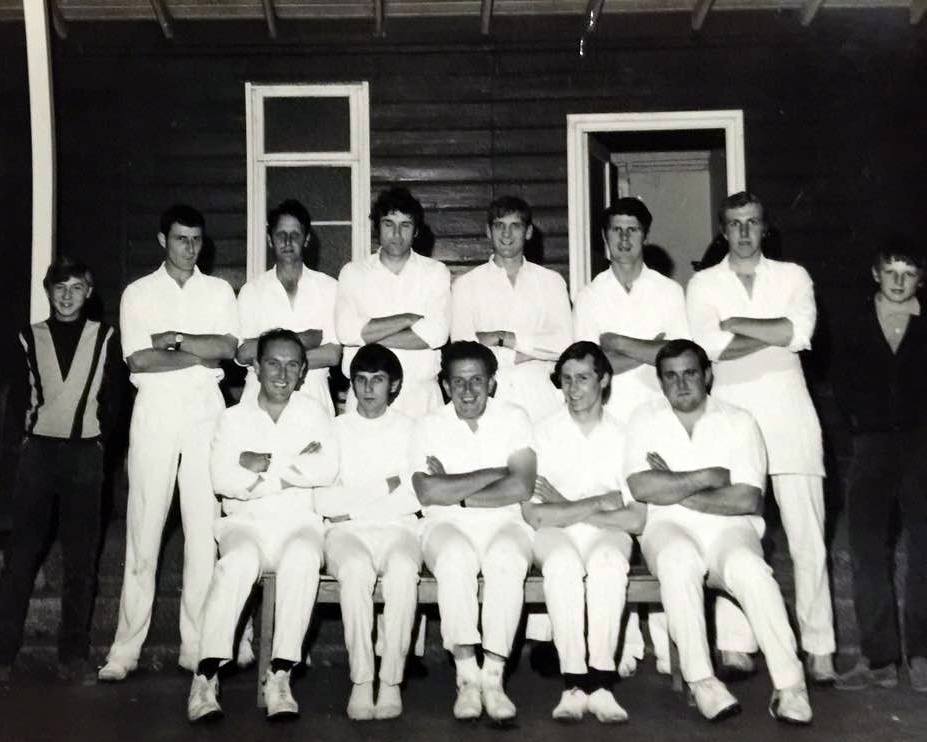
Football
Whilst cricket tended to be for the upper classes in the early years football was popular with labourers and those in trade. Nationally the popular version of the game with similar rules to the way the game is played today was established in the 1870’s. The game proved very popular amongst the working classes but did not take off in Martham until at least 1891 when the advert shown on the left below appeared in the Yarmouth Independent on 5th December. Progress may have been slow, however, because it was not until 1906 that the report shown below on the right indicates that the first game took place on a field provided by the farmer and butcher George Chapman.
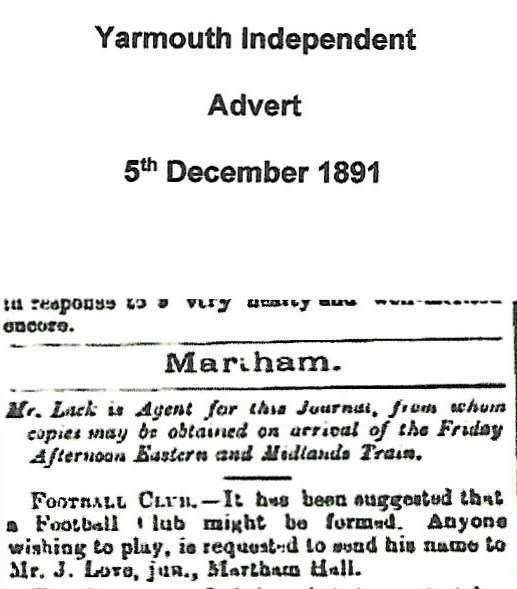
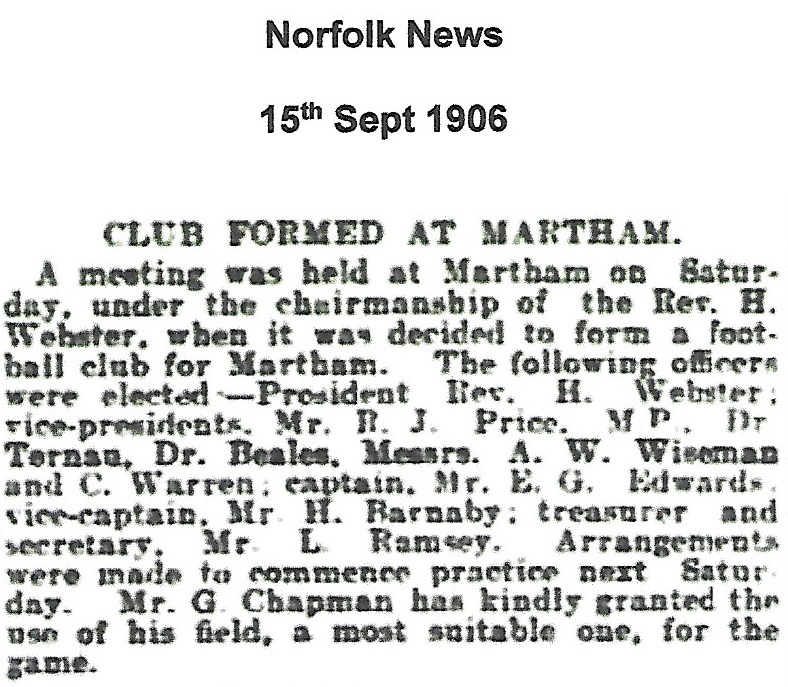
Below are two photographs that are said to be of very early Martham teams from about the period of the above adverts but the exact years are unknown.
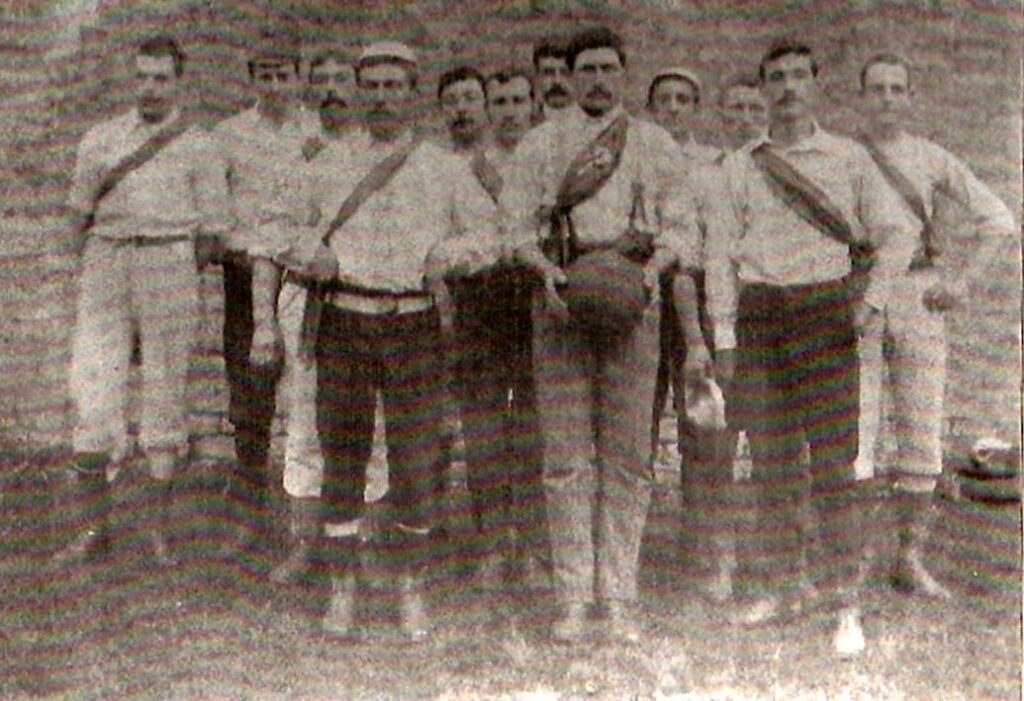
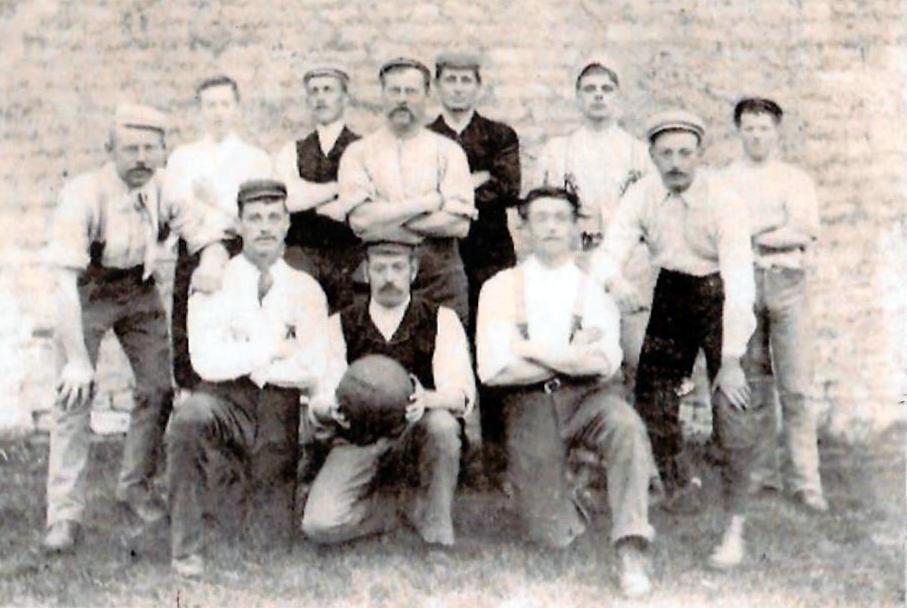
Friendly games were recorded between Martham, Hemsby and Caister during 1907-08 and 1908-09 and on 29th July 1909 a meeting was held in Caister where a new league was proposed. Five village teams, including Martham, took part and they played for the ‘Fitch Cup’ which was a new trophy donated by Mr Cecil Fitch the prospective parliamentary candidate for East Norfolk. In those days the Martham team was known as the ‘Saints’.
The start of the 1911-12 season saw Martham replace Somerton in the Flegg League whilst a local rule change required “that every player should play for his club in the village he resides, failing no club in his own village, he should play for the club whose ground he resides nearest to”. It makes you wonder if the Somerton withdrawal provided Martham with a wider pool of available players. Rollesby won the league based on a superior goal average even though Martham had the same number of points as their rivals. Martham were presented with a Consultation Cup at their annual club dinner by Mr. R Futter.
The following season illustrated the popularity of the game in Flegg when 500 people were said to attend a concluding match between Hemsby, the league winners, and a representative team from other villages. It was reported as a great day for Flegg football and it augers well for the future of the league. Little did they know that only a few months later many of the young players would be fighting in WW1 and some would never return.
Organised Flegg League matches did not start again after the war until the 1920-21 season which also saw teams compete for the Flegg Charity Shield (knockout competition) final which was played at Martham on 28th March 1921 in front of an incredible estimated crowd of 3,000. People came from all over Flegg in coaches and by train to see Caister beat Ormesby 2-0. The following year another crowd of over 2,000 witnessed the final in Martham again. Other villages seem to have been dominant over this period and Martham was therefore selected as a neutral venue for cup finals.
At the end of the 1927-28 season the final of the Flegg ‘A’ Charity Shield match was again played on Easter Monday at Martham on Captain Jeary’s field but this time in front of an estimated crowd of 1,000 raising funds for the Flegg Nursing Association.
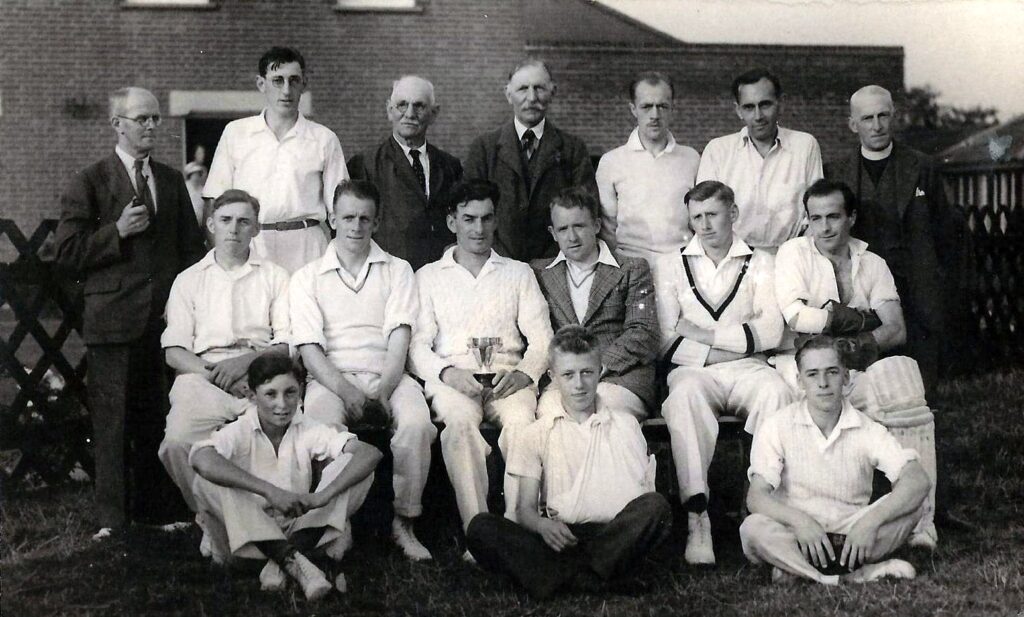
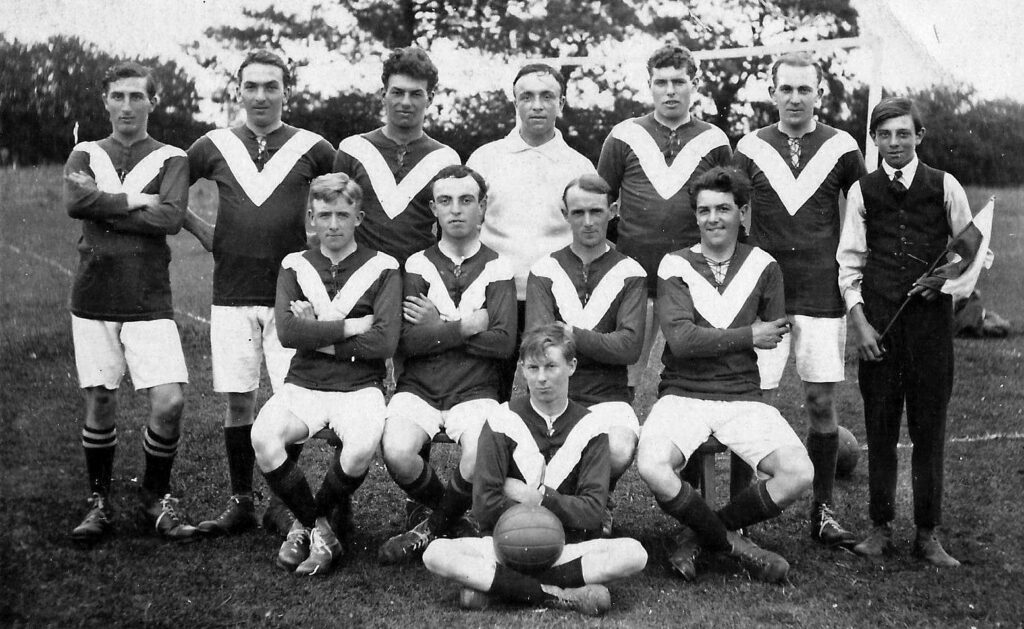
The post WW1 enthusiasm for the game began to wain and several local teams made irregular appearances from one season to another or withdrew part way through the season. Martham faired no better than the others and football came to a halt as the 1939-40 season found the country at war once again. The Flegg League started again in 1946-47 made up of teams from Caister, Fleggburgh, Hemsby, Martham, Ormesby, Repps and Rollesby. Bad weather gave rise to many postponed games and it was not until the end of May that the final games was played. Martham beat Hemsby 1-0 to win the Charity ‘A’ Shield on Easter Monday for the first time it was played since 1920. The Flegg League folded at the end of the 1947-48 season with Martham finishing fourth out of five teams.
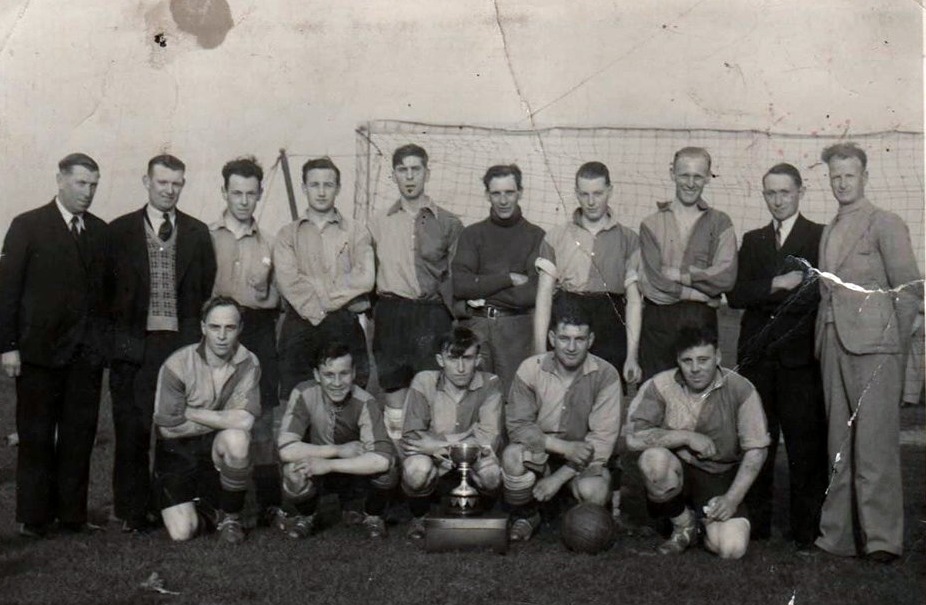
The demise of the Flegg League was countered by a resurgence in popularity of the game in Great Yarmouth where 42 teams (including reserves) played in three divisions. Martham were included with three teams; Martham First Team in Division 2; Martham Reserves in Division 3B and an Under 18’s Team in the Minor League.
After the war many teams had struggled to put out teams, only Rollesby had its own playing field and the dominance of the town teams in the Yarmouth and District League resulted in lean years for Flegg village teams. Eventually Martham got its own ground in 1953 when the Coronation Recreation Ground was opened in Rollesby Road but nothing was going to see a return to the popularity of the local game during the inter war years.

Two photographs of teams below but with unknown dates.
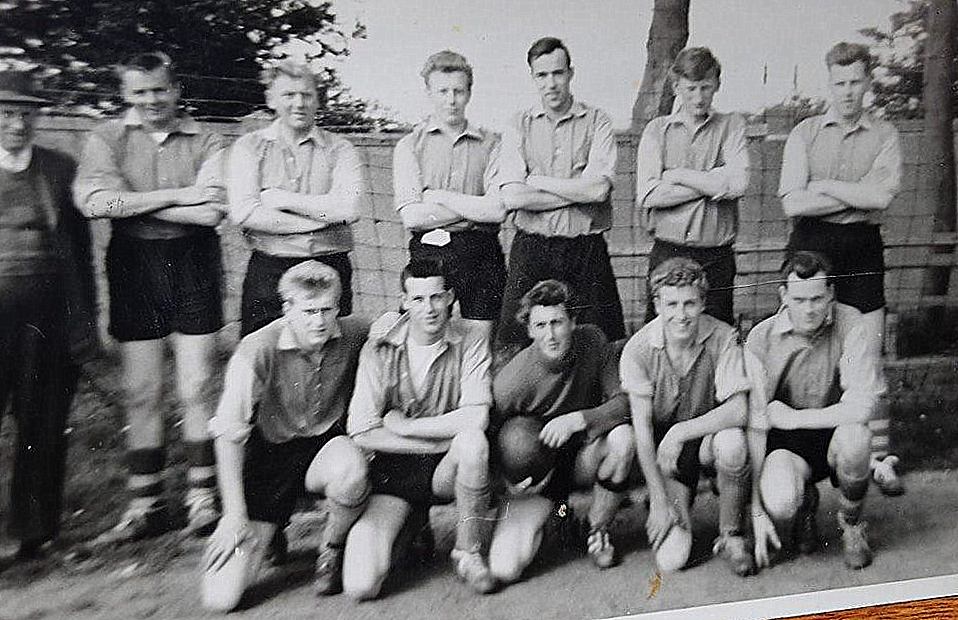
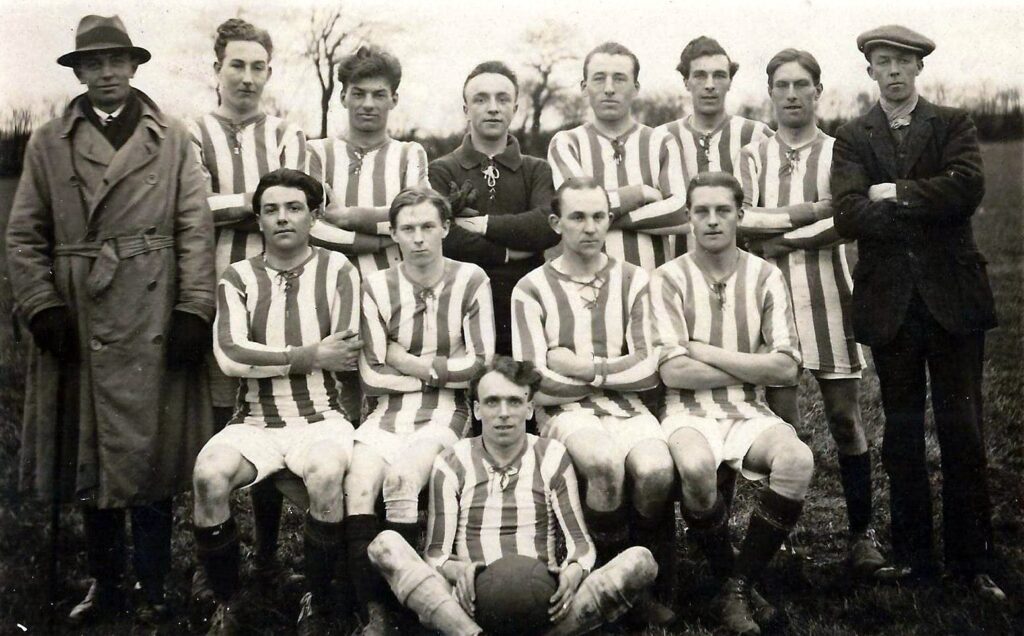
Quoits
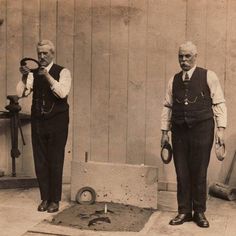
Quoits was a popular game in Martham and the surrounding area in the late 19th and early 20th century. It is a game played with metal discs, traditionally made of steel and thrown at metal spikes (called a pin, hob or mott) set 11 yards apart. The spike is centrally, and vertically, positioned in a square of moist clay measuring three feet across. Quoits measure about 5½ inches in diameter and weigh around 5½ pounds.
This version uses the 15 rules published in ‘The Field’ in 1881 and has remained largely unchanged since that time. Played under the auspices of The National Quoits Association, formed in 1986.
The Long Game
There is a version called the long game or old game where the top of the spike is flush with the clay, so encircling the pin is not a significant part of the game. The long game has similarities to the game of bowls, in that a player scores a point for each quoit nearer to the pin than his opponent. The hobs are 18 yards apart, while the quoits are typically around nine inches in diameter and weigh up to 11 pounds.
East Anglian Game
Locally it is most likely that participants played the East Anglian version of the long game, using quoits of reduced size and weight. As with the long game, the hobs are 18 yards apart, but their tops are raised above the level of the clay. Quoits that land cleanly over the hob score two points, regardless of the opponent’s efforts, and are removed immediately, prior to the next throw.
By 1900 the game was flourishing at Martham and the medal below is thought to have been awarded for what was later known as the Clippesby Cup, it was first played for in 1904 and was won by Martham who beat Rollesby 142-129 at Repps.
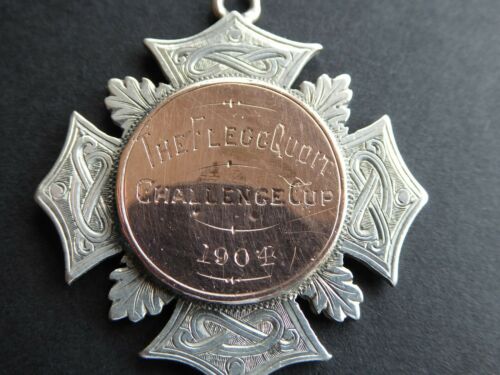
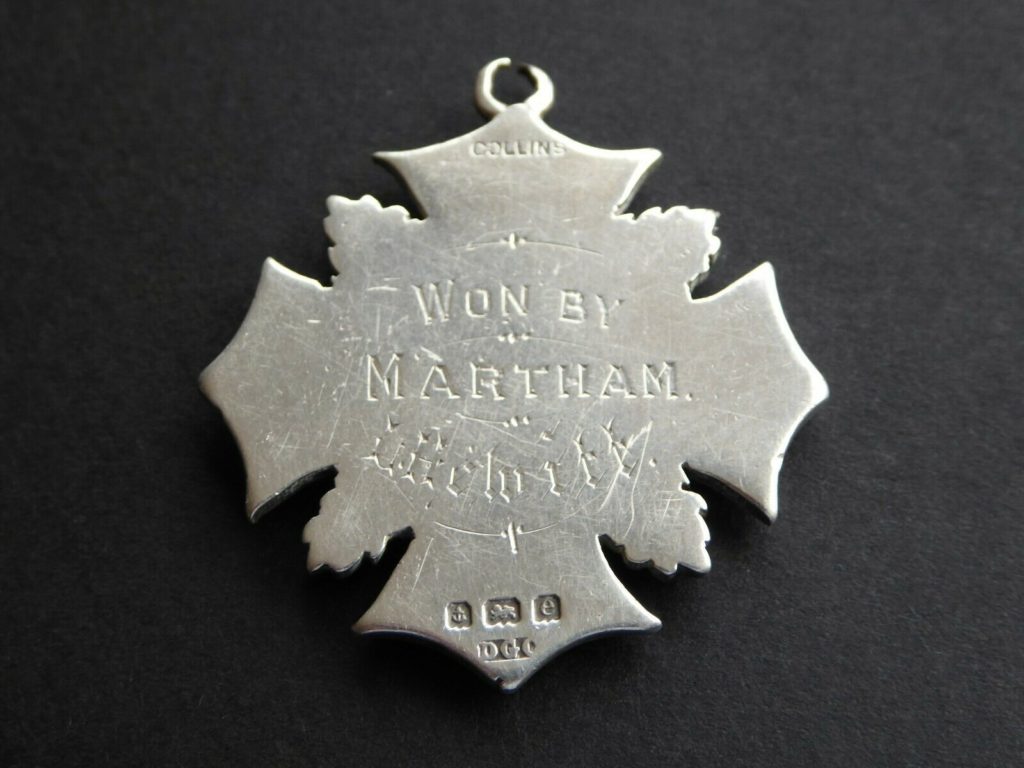
The above quoit medal was for the 1904 Fleggburgh Challenge Cup winner who was believed to be Mr Louis Hewitt who played for Martham but lived at Varley Cottages, Somerton. His wife was called Selina and in 1911 they had three children who had all been born in Martham.
The popularity of the game in the village was demonstrated at the club’s end of season competition in 1906 when 37 members took part in the club cup. In the same year the club won the Clippesby Cup for the third year running and consequently were presented with the cup to keep.
Quoits was confined largely to the West Flegg villages but seemed to die out after about 1932.
I would like to thank Sid Watkinson, whose Grandfather was Quoits Champion of England in 1904.
Plus Steve Clarke and Janette Tooke for information they provided to help with this page.
Also David Tubby whose wonderful book “Life in the Flegg Villages 1800-1950” I heartily recommend.
